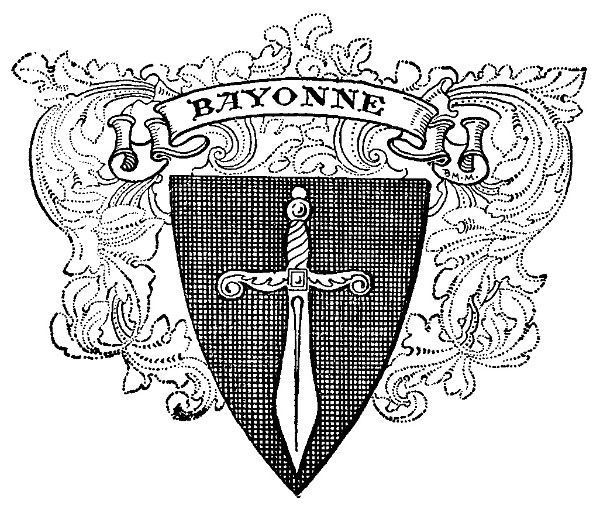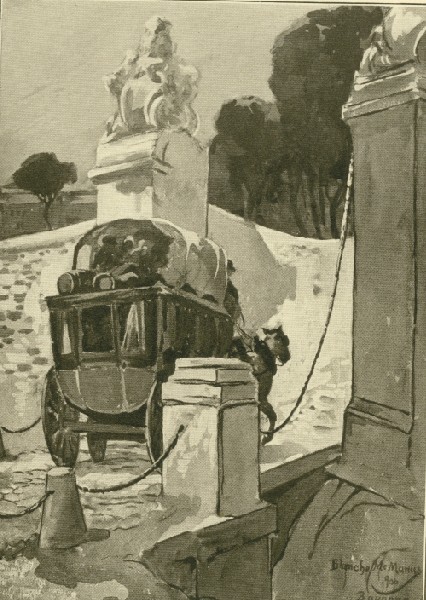| Web
and Book design,
Copyright, Kellscraft Studio 1999-2010 (Return to Web Text-ures) |
Click
Here to return to
Castles and Chateaux of Old Navarre and the Basque Provinces Content Page Return to the Previous Chapter |
 (HOME)
|
| CHAPTER XXVIII
BAYONNE: ITS PORT AND ITS WALLS  ARMS OF BAYONNE THE foundation of Bayonne is lost in the obscurity of ages, but it was the capital of the Basque country. Three distinct quartiers are formed by the flowing waters of the Nive and the Adour, communication being by a series of exceedingly picturesque, if not exactly serviceable, bridges. The bridges of Bayonne are famous in the eyes of artists, and lovers of damp, moss-grown and weathered masonry, but an engineer of this age of steel would consider them inefficient abominations, and not at all suited to a great port and sous-préfecture such as Bayonne. One of the finest works of Vauban, the fortress builder, was the defences of Bayonne. The walls and ramparts were exceedingly efficacious in times past (though to-day they look flimsy enough), and crowning all, was a superb fortress at the juncture of the two rivers which come together here, flowing from the fastnesses of the Pyrenees to the sea. The Allées Marines at Bayonne, a sort of tree-covered jetty-promenade, are a unique feature in civic embellishment. The water-gate at Bordeaux is fine, and so is the Thames Embankment in London, and the Battery in New York, but those Allées at Bayonne lead them all. The Adour, coursing its way to the sea down through Bayonne, was fickle enough one day to leave its bed, and force an outlet three leagues or more away, threatening disaster to Bayonne's port. The citizens rose in might and took counsel, and decided that something must be done or they would die of sheer ennui, if not of poverty. There came to the rescue one Louis de Foix, the same who had been the architect of Spain's Escurial, and in 1579 he harnessed the water's flow and returned it to its ancient bed.  A GATEWAY OF BAYONNE Bayonne glories in the fact that she has never submitted to a foreign yoke, and when taken from the English, who had usurped it as a Plantagenet birthright, by Charles VII, in the fifteenth century, the people of Bayonne recognized that they had come to their own again through the efforts of their fellow Basques. The city's device "Nunquam Polluta" is distinctly appropriate. It was to Bayonne that François Premier came to meet his court, after his days of imprisonment at Madrid, as the hostage of his old enemy Charles V. He was confined only in the luxuriously appointed palace at Madrid, but, as he himself said, "the cage was none the less a cage for being gilded." Here at Bayonne awaited François' mother, his sister Marguerite, and a gay court of followers, not forgetting "a brilliant parterre of young beauties assembled in their train," as Du Bellay puts it. François' adoration for "brilliant parterres" of young ladies was ever one of his failings, and the master of ceremonies of the temporary court of Bayonne thought enough of his position to get together an entrancing bevy, the most beautiful among them all being the famous Anne de Pisseleu, she who was afterwards to become the Duchesse d'tampes. Diane de Poitiers was there too, having come to Bayonne as lady in waiting to the regent, but it was Anne de Pisseleu who won François' favour of the moment, and he even allowed her to publicly refer to the insistent Diane as "an old hag," and declare that she herself was born on Diane's wedding day. This was after he had put aside Diane. Vicomte d'Orth was governor of Bayonne on that dread Bartholomew's night when the tocsin rang out all over the French domain. He wrote to Charles IX as follows, showing the fidelity and steadfastness of the people of these parts, when in more frigid climes they lost their heads in an uncontrollable fury: "I have communicated the letter of your Majesty to the garrison, and to the inhabitants of the city; I have found only brave soldiers and good citizens and not a single murderer." Bayonne to-day is frankly commercial; its docks and wharves are possessed of a considerable deep-sea traffic; and one sees three masters from the Banks of Newfoundland, and cargo-boats from Senegal, side by side at its quays. It is, too, the distributing depot for the whole Basque country, the chief market where the peasant goes to buy Seth Thomas clocks and Smith and Wesson revolvers, each made in Belgium most likely; in England and America the cry is "made in Germany;" in France, it's "made in Belgium." All of the Basque country, and a part of Béarn, depend on Bayonne for certain supplies; even Biarritz and Saint-Jean-de-Luz are but its satellites. Walckenaer's "Géographie des Gauls" says the evolution of the name Bayonne was from the Basque Lapurdam, "city of thieves," but nothing to-day about her warm welcome for strangers justifies this, so it were best forgot. Bayonne in the old days — and to some extent to-day — spoke intermittently Gascon, Français, Béarnais and Spanish, and it is this notable blend of peoples and tongues that makes it so charming. The Quartier Landais was the mother city of Bayonne, the oldest portion out of which the other faubourgs grew. Within the old walls, and in the narrow streets, all is mediæval even now, but in the newer quarters the straight, rectangular lines of streets and sidewalks are, as the French call them, à l'Américaine. The Pont Mayon at Bayonne is the liveliest, gayest spot in all the Basque country. It is the virtual centre of this ancient capital. Bayonne's cathedral is lovely enough when viewed from afar, particularly the ensemble of its spires with the roof-tops of the town — a sort of reminiscence of Nuremberg — and this in spite of the fact that Taine in his description of it called it ugly. In the olden times, the city had an important Jewish quarter, whose inhabitants were an overflow of those expelled from Spain and Portugal. This little city of the Landes became a miniature Frankfort, and had three synagogues where the rabbis held services in the Spanish tongue. The phenomenon has disappeared, by a process of evolution and infusion, and one no more remarks the Jewish type as at all distinct from the Basque. An incident happened at Bayonne fort during the Peninsular War which seems to have been greatly neglected by historians, though Gleig, the novelist, in "The Subaltern," makes much of it. The English, believing that peace had been declared, resented an unprovoked French sortie from Bayonne's citadel on the tenth of April, 1814. This was the last British fight on French soil, if fight it was. A number of the guards, including four officers, died of wounds received at this engagement. The following anonymous verses tell the story well: "For
England here they fell.
Yon sea-like water guards each hero's grave. Far Pyrenean heights, mindful, attest That here our bravest and our best Their supreme proof of love and loyalty gave, Dying for England well. "Among those distant heights, Had many a day the wrathful cannon roared. Through black ravine and sunny field of Spain War's headlong torrent rolled amain. Irun's defile and Bidassoa's ford Beheld a hundred fights. "Last, by this sea-like wave, Threatening the fort our martial lines were drawn. Fierce broke upon their watch at midnight hour The swift sortie, the bullets' shower. Red carnage ceased with slowly wakening dawn. France keeps the true and brave." A kilometre or two outside the walls of Bayonne — the same which defied the British in 1814 — is a guide-post bearing the inscription (the writer thinks in English) "To the Guards' Cemetery." Down a by-road around a turning or two, and past a score of vine-clad cottages of Basque peasants one comes to the spot in question, a little railed-in plot of hallowed ground. Here are seen the original weatherworn headstones of nearly a century ago, and a newer series, practically replicas of the former. There is also a tablet stating that on this spot stood the "Third Guards Camp." That is all. It resembles the conventional cemetery not at all, and may be considered a memorial, nothing more. Certainly there is nothing pathetic or sad about it, for all is green and bright and smiling. If one can put themselves in this mood it is certainly a good one in which to make a pilgrimage to a city of the dead. There is another warlike reminiscence connected with Bayonne, which is worth recalling, and that is that Bayonne was the birthplace of the bayonet, as was Troyes (in France) the birthplace of that species of weights which is not avoirdupois. A mid-Victorian writer in England criticized Dickens' story in Household Words, called "Perils of Certain English Prisoners," wherein the soldiers carried bayonets in their muskets and cartridges in their haversacks. This particular critic nodded, as they sometimes do. Cartridges were invented in 1586, and bayonets first made their appearance at Bayonne in 1641, and the scene of Dickens' tale was laid a hundred or two years later. Those who think that York ham, which even the French know as Jambon d'Yorck, is a superlative sort of pig-product, should become acquainted with the jambons de Bayonne, from Basque pigs, cured with the natural salts of the commune of Salies. There is no room left for comparison with other hams. Those of Bayonne are the peers of their class, not forgetting even the sugar-cured variety of the Old Dominion. There is a considerable chocolate business at Bayonne, too, though not with the interior, which mostly gets its supplies from Paris, but with the French colonies, notably with the tiny market of St. Pierre-et-Miquelon, which, by some business pact or reasoning, is held to be sacred to the chocolate manufacturers of Bayonne. |